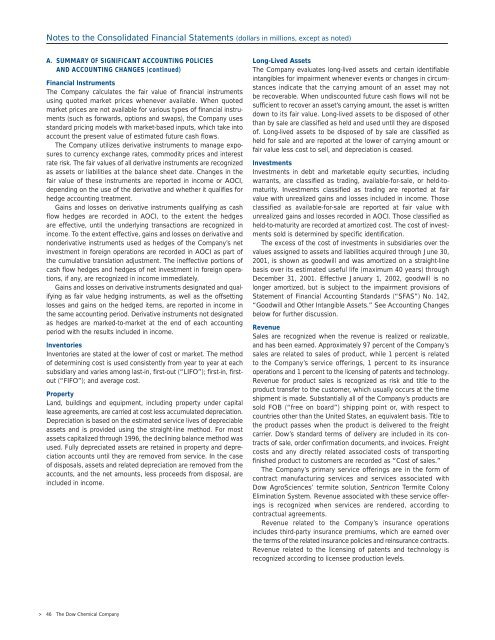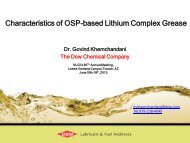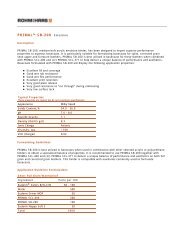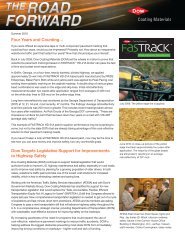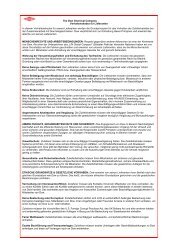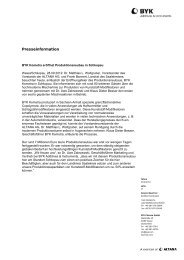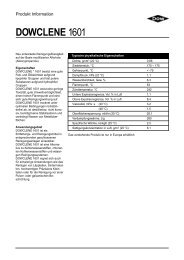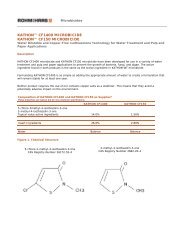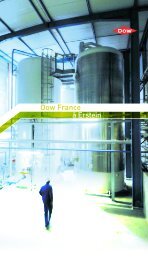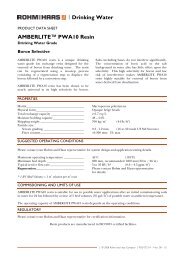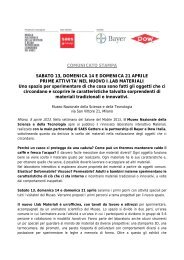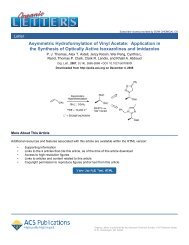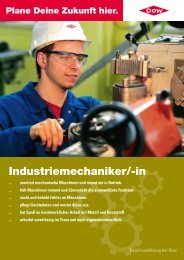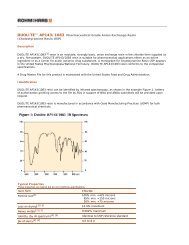Focus - The Dow Chemical Company
Focus - The Dow Chemical Company
Focus - The Dow Chemical Company
You also want an ePaper? Increase the reach of your titles
YUMPU automatically turns print PDFs into web optimized ePapers that Google loves.
Notes to the Consolidated Financial Statements (dollars in millions, except as noted)<br />
A. SUMMARY OF SIGNIFICANT ACCOUNTING POLICIES<br />
AND ACCOUNTING CHANGES (continued)<br />
Financial Instruments<br />
<strong>The</strong> <strong>Company</strong> calculates the fair value of financial instruments<br />
using quoted market prices whenever available. When quoted<br />
market prices are not available for various types of financial instruments<br />
(such as forwards, options and swaps), the <strong>Company</strong> uses<br />
standard pricing models with market-based inputs, which take into<br />
account the present value of estimated future cash flows.<br />
<strong>The</strong> <strong>Company</strong> utilizes derivative instruments to manage exposures<br />
to currency exchange rates, commodity prices and interest<br />
rate risk. <strong>The</strong> fair values of all derivative instruments are recognized<br />
as assets or liabilities at the balance sheet date. Changes in the<br />
fair value of these instruments are reported in income or AOCI,<br />
depending on the use of the derivative and whether it qualifies for<br />
hedge accounting treatment.<br />
Gains and losses on derivative instruments qualifying as cash<br />
flow hedges are recorded in AOCI, to the extent the hedges<br />
are effective, until the underlying transactions are recognized in<br />
income. To the extent effective, gains and losses on derivative and<br />
nonderivative instruments used as hedges of the <strong>Company</strong>’s net<br />
investment in foreign operations are recorded in AOCI as part of<br />
the cumulative translation adjustment. <strong>The</strong> ineffective portions of<br />
cash flow hedges and hedges of net investment in foreign operations,<br />
if any, are recognized in income immediately.<br />
Gains and losses on derivative instruments designated and qualifying<br />
as fair value hedging instruments, as well as the offsetting<br />
losses and gains on the hedged items, are reported in income in<br />
the same accounting period. Derivative instruments not designated<br />
as hedges are marked-to-market at the end of each accounting<br />
period with the results included in income.<br />
Inventories<br />
Inventories are stated at the lower of cost or market. <strong>The</strong> method<br />
of determining cost is used consistently from year to year at each<br />
subsidiary and varies among last-in, first-out (“LIFO”); first-in, firstout<br />
(“FIFO”); and average cost.<br />
Property<br />
Land, buildings and equipment, including property under capital<br />
lease agreements, are carried at cost less accumulated depreciation.<br />
Depreciation is based on the estimated service lives of depreciable<br />
assets and is provided using the straight-line method. For most<br />
assets capitalized through 1996, the declining balance method was<br />
used. Fully depreciated assets are retained in property and depreciation<br />
accounts until they are removed from service. In the case<br />
of disposals, assets and related depreciation are removed from the<br />
accounts, and the net amounts, less proceeds from disposal, are<br />
included in income.<br />
> 46 <strong>The</strong> <strong>Dow</strong> <strong>Chemical</strong> <strong>Company</strong><br />
Long-Lived Assets<br />
<strong>The</strong> <strong>Company</strong> evaluates long-lived assets and certain identifiable<br />
intangibles for impairment whenever events or changes in circumstances<br />
indicate that the carrying amount of an asset may not<br />
be recoverable. When undiscounted future cash flows will not be<br />
sufficient to recover an asset’s carrying amount, the asset is written<br />
down to its fair value. Long-lived assets to be disposed of other<br />
than by sale are classified as held and used until they are disposed<br />
of. Long-lived assets to be disposed of by sale are classified as<br />
held for sale and are reported at the lower of carrying amount or<br />
fair value less cost to sell, and depreciation is ceased.<br />
Investments<br />
Investments in debt and marketable equity securities, including<br />
warrants, are classified as trading, available-for-sale, or held-tomaturity.<br />
Investments classified as trading are reported at fair<br />
value with unrealized gains and losses included in income. Those<br />
classified as available-for-sale are reported at fair value with<br />
unrealized gains and losses recorded in AOCI. Those classified as<br />
held-to-maturity are recorded at amortized cost. <strong>The</strong> cost of investments<br />
sold is determined by specific identification.<br />
<strong>The</strong> excess of the cost of investments in subsidiaries over the<br />
values assigned to assets and liabilities acquired through June 30,<br />
2001, is shown as goodwill and was amortized on a straight-line<br />
basis over its estimated useful life (maximum 40 years) through<br />
December 31, 2001. Effective January 1, 2002, goodwill is no<br />
longer amortized, but is subject to the impairment provisions of<br />
Statement of Financial Accounting Standards (“SFAS”) No. 142,<br />
“Goodwill and Other Intangible Assets.” See Accounting Changes<br />
below for further discussion.<br />
Revenue<br />
Sales are recognized when the revenue is realized or realizable,<br />
and has been earned. Approximately 97 percent of the <strong>Company</strong>’s<br />
sales are related to sales of product, while 1 percent is related<br />
to the <strong>Company</strong>’s service offerings, 1 percent to its insurance<br />
operations and 1 percent to the licensing of patents and technology.<br />
Revenue for product sales is recognized as risk and title to the<br />
product transfer to the customer, which usually occurs at the time<br />
shipment is made. Substantially all of the <strong>Company</strong>’s products are<br />
sold FOB (“free on board”) shipping point or, with respect to<br />
countries other than the United States, an equivalent basis. Title to<br />
the product passes when the product is delivered to the freight<br />
carrier. <strong>Dow</strong>’s standard terms of delivery are included in its contracts<br />
of sale, order confirmation documents, and invoices. Freight<br />
costs and any directly related associated costs of transporting<br />
finished product to customers are recorded as “Cost of sales.”<br />
<strong>The</strong> <strong>Company</strong>’s primary service offerings are in the form of<br />
contract manufacturing services and services associated with<br />
<strong>Dow</strong> AgroSciences’ termite solution, Sentricon Termite Colony<br />
Elimination System. Revenue associated with these service offerings<br />
is recognized when services are rendered, according to<br />
contractual agreements.<br />
Revenue related to the <strong>Company</strong>’s insurance operations<br />
includes third-party insurance premiums, which are earned over<br />
the terms of the related insurance policies and reinsurance contracts.<br />
Revenue related to the licensing of patents and technology is<br />
recognized according to licensee production levels.


